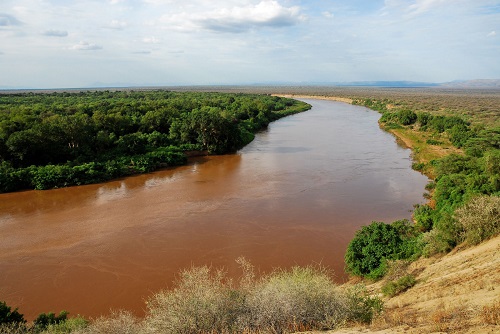
The Omo River is the second largest river in Ethiopia, next to the Blue Nile (Abbay) River. The Omo River Basin is also the largest source of Ethiopia’s hydro-power energy where the Gibe I, Gibe II, Gibe III power plants are found and the Gibe IV power plant is under construction. In addition, Ethiopia has further plans to build Gibe IV and Gibe VI hydropower plants.
The basin covers a catchment area of more than seven thousand square kilometres within three regional states in Ethiopia, the Southern Nations, Nationalities and Peoples State, Oromia State and the newly established South West Ethiopia State.
Though the basin area is rich in natural resources and forest coverage with around seven natural parks and different dense forests including the Kaffa and Bench Sheko dense forests, through time land degradation, soil erosion and unwise use of natural resources are affecting the basin.
To protect the natural ecology and forest coverage of the basin by identifying the major problems and affected areas of the basin, Wolaita Sodo University has started a new initiative entitled “Omo Basin Strategic Project” which is currently in its characterization phase.
Recently, the university has organized a discussion with stakeholders in Addis Ababa to discuss the next phases of the research project on the basin mainly to gather inputs for the project. During the discussion, Wolaita Sodo University Community Based Service Director, Dawit Dalga (PhD) said that a lot of national projects are taking place on the Omo Basin.
Dawit added that the implementation of the Basin’s Strategic Plan is a timely action to exploit the basin’s development potential by preserving and conserving the ecology and nature of the basin. He added that soil conservation and protection of land degradation will remain the thematic areas of the project on the basin.
Experts from Ethiopian Basin Development Authority said during the discussion that water is a key source of development and protecting the basin areas is a critical and timely investment for the sustainability of the water flow and ecology of the area. Hence, the experts stated that researching the demography, water politics, ecology and way of life of the settlers of the basin is necessary to protect the basin and the development projects in the area.
Approached by The Ethiopian Herald, Researcher at Wolaita Sodo University and Omo-Gibe Basin Project Team Leader, Abraham Asha (PhD) said that the Omo Basin is the source of Ethiopia’s hydro-power energy where the Gibe I, Gibe II and Gibe III power plants are found.
Dr Abraham stated that the Omo-Gibe River Basin covers a broad area located in three regional states in Ethiopia bordering South with Lake Turkana, East with Rift Valley, and North with Awash and Blue Nile basins and West with Baro-Akobo River Basin. He added that the basin is home to Ethiopia’s main hydropower plants, seven natural parks and protected dense forests.
Abraham stated that the Omo-Gibe River Basin has a huge potential for Ethiopia’s economic development in tourism, hydro-power energy, agriculture, livestock and forest. The basin has two faces. On one side it is covered by dense forests and protected areas while the other part of the basin is affected by land degradation, drought, and deforestation, overgrazing and flooding. The basin through time is losing its natural ecology and forests. Especially, the lower stream basin is severely affected by flooding and sedimentation during the rainy season and drought during dry seasons.
Hence, Abraham said, the basin needs interventions to protect the natural ecology of the basin and to exploit the resource potential of the area including improving the livelihoods and lifestyle of the farmers and pastoralists living in the basin areas. Aiming at protecting the basin’s natural ecology and solving the problems that the basin is facing, Wolaita Sodo University launches Omo Basin Strategic Project, he noted.
“With this plan, which is undertaken with multi-stakeholders,” Abraham said, “the university aims to identify the major problems of the basin that is facing currently, characterizing the water sources and try to put strategic solutions for the identified problems.” If properly harnessed the basin avails a big development potential for the country, he noted adding that to exploit the potential, it needs conservation and protection investment before it loses its natural ecology.
“Soil erosion, land degradation, the increasing unwise of dense forests, overgrazing are among the top problems of the basin, he said. The University’s project, according to Abraham is mainly to identify the source of these problems, the solutions and the development potentials of the basin.
The land around the upper area of the Gibe III is highly and continuously degrading, the researcher stated adding “in addition, the lower basin areas are affected by flooding during rainy season and drought during the sunny season” Flooding and drought is a high risk in the lowland basin where thousands are displaced annually, he added.
“Currently the research project of the university is on its characterization phase,” Abraham said. Different multi-stakeholders discussions are preparing to enrich the project plan with ideas from stakeholders. The first discussion was held in Addis Ababa and another discussion forum is scheduled to be held in Jimma, Oromia state soon. Another discussion will be also scheduled to be held recently in Jinka town, South West Ethiopia State, he added.
Characterization of the basin, identification of the problems, selecting the high-risk areas of the basin and forwarding strategy for strategic action are the goals of the project plan, he noted. This aims that, he noted, by identifying the high, medium and minimum risk areas of the basin, it will recommend types of interventions and the actors for the interventions. In this regard, new intervention investments and interventions to protect and conserve the available natural ecology are the targets.
To take practical actions, the strategic plan aims to divide the responsibility to the local administrations, universities found in the basin area, zonal and regional administrations, federal and donor actors.
BY DARGIE KAHSAY
The Ethiopian Herald 31 October 2021





